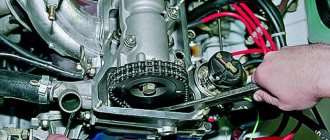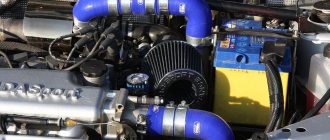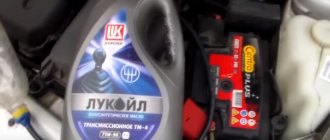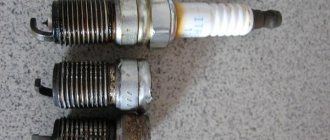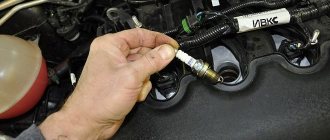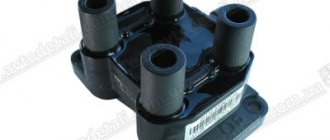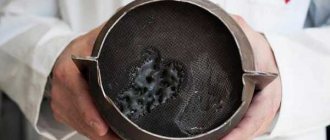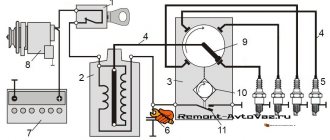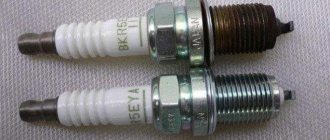In order to determine the malfunction, you just need to take a closer look at the behavior of the car. Typical signs of problems with ignition coils are as follows:
- the engine begins to “trouble”, unstable operation of the power plant is noted, the more time passes from the moment the problem appeared, the worse the engine performs;
- The poor performance of the unit is especially noticeable at sub-zero temperatures; the situation more or less normalizes only after the engine warms up. In addition, the problem may occur frequently if the machine is located in an area of high humidity;
- when you sharply press the gas pedal on the engine;
- There is a special indicator on the instrument panel, the so-called Check Engine. It signals to the car owner that there is some kind of malfunction in the car’s power circuit. You can decipher the indicator readings using the instruction manual that came with the car upon purchase.
Diagnosing a failure of an element is not difficult; it is more difficult to identify which part is not working. Each cylinder in the Priora has an individual coil installed; there is no ignition module on the car. Therefore, you will have to run each of them with a multimeter and check each tip. Special attention should be paid to the caps, because if a problem happens to them, you won’t have to change the part. To identify the problem, you just need to remove the element and clamp it with pliers. If the silicone from which the part is made begins to wrinkle, then the tip needs to be replaced. If, when compressed, it remains even and smooth, then the problem lies in something else.
Which reel to buy
Many car enthusiasts advise buying the cheapest devices. Why is that? It is believed that the coils burn primarily due to a poor-quality spark plug. Of course, it would be useful to make sure that all the spark plugs are in good working order, but even if there are no problems, but the coil still burns out, it is recommended to replace the spark plug in the cylinder where the malfunction occurred. At the same time, not all car owners are ready to trust the most budget reels, and such an opinion also has a right to life.
Experienced car enthusiasts advise purchasing products from one of two brands:
- Omega.
Please note right away that the cost of devices can be quite high. For example, one Bosch coil costs about 700 rubles. Taking into account the fact that 4 parts are needed to replace at once, this amounts to a considerable amount. Which option will be best for you is up to you to decide.
However, do not forget to make sure that the spark plug in the cylinder where the burnt part was installed is in good condition. If there is a problem, even the highest quality and most expensive reel will not last long.
Despite the huge amount of criticism against the Lada Priora, this is one of the most popular cars that have come out of the AvtoVAZ assembly line in recent years. The Priora is equipped with a fairly successful engine with good dynamics, and the interior is very comfortable. And the maximum trim levels offer useful options. But at the same time, from time to time the car brings minor problems to its owners. One of the most popular malfunctions is that the Priora engine (16 valves) is tripping. The reasons for this phenomenon are quite unpleasant. And besides, the motor eventually overheats.
When the driver starts his car in the morning, the engine does not run smoothly as before, but intermittently. At this time, dull sounds are heard from the exhaust pipe. At the same time, a persistent and strong smell of unburned fuel is felt. Vibrations are constantly increasing, and this is fraught with cracks in the pillows. This is how the engine runs when cold.
Trouble the engine: why is it dangerous?
This is a rather critical phenomenon, especially if the unit begins to vibrate during acceleration. This behavior of the engine is especially dangerous when the driver decides to overtake, but there are cars in the oncoming lane. In the process, while the motor is running, the engine power is significantly reduced. The compression ratio decreases - there may not be enough dynamics to successfully complete the maneuver.
Considering that the Lada Priora has been manufactured since 2007, there are often instances where the engine knocks like on an old car 20 years ago. This is an engine running on three cylinders. It may have the latest firmware, but if the engine of a Lada Priora car is running rough and the check light is on, then such a car will not have much life left.
Typical reasons and safety precautions
It is worth considering that there are many possible reasons why one of the cylinders turns off. Some faults can be identified and eliminated even without material costs. Others are diagnosable. As a result, engine replacement or major repairs may be required.
Supply system
If the Priora engine (16 valves) is tripping, the reasons may be trivial. When there is no flash in the cylinder, perhaps there is simply no fuel there. If it has a normal compression ratio, it is worth diagnosing the power system. You should pay maximum attention to the air filter and the pipe. It is necessary to make sure that the clamps are securely tightened, whether the purifier body itself is intact, and whether there is any air leakage from the outside. Also pay attention to the tubes. They must be tightly secured to the throttle assembly. Fuel leaks, cracks, and broken plastic may indicate that some parts are faulty.
Nozzle failures, clogging
When the Priora engine (16 valves) fails, the reasons often lie in the injector.
It may be faulty or simply blocked. Beginners and those who like to pour various injector cleaning fluids into the tank often encounter this problem. All this leads to the fact that the dirt first peels off in the tank, then in the fuel line. And eventually it will end up in the injectors, where it will happily get stuck.
Injector winding
It can not only become clogged with dirt - often the windings of the elements burn out on Priors. In this case, the situation can be easily restored with your own hands. The cover is removed, and then the manifold. Next, the injector windings are checked. Using a multimeter, measure the resistance of the windings. It should be around 11-15 ohms. If the indicators are lower, the element should be replaced.
How to troubleshoot injector problems?
If the resistance is normal, then it is recommended to completely dismantle the fuel rail and thoroughly wash each part. You should not perform this operation if you have no experience in this work. To flush, the nozzle valves must be opened. Then apply aerosol washing there under pressure. It's not difficult, but without experience you can ruin everything.
Poor quality fuel
This is one of the possible reasons why the engine stalls at idle or while driving. To return to normal operation, you can try changing the gas station. This usually helps clear up a lot of misunderstandings. It is better to fill the 16-valve Priora engine with good 95-octane gasoline. It's not worth pouring something with a higher octane number. This will only lead to overheating. You can also try replacing the air and fuel filters. Sometimes this solves the problem.
Ignition system
An experienced car enthusiast who is faced with an engine running on three cylinders immediately begins to diagnose the spark plugs. The Lada Priora must cool well, otherwise there is a risk of getting burned when unscrewing it. If after a few seconds you turn off the ignition and check the spark plugs, one of them will be wet with gasoline. It is also recommended to separately check each part for the presence of a spark. In case of malfunction, the problem is solved by replacing the spark plug. Sometimes it is enough to press down a potentially faulty one with a cap and the machine will resume normal operation. In general, the ignition system in this car is the most problematic part. If the Priora engine (16 valves) is malfunctioning, you can look for the reasons for a very long time, and diagnostics will not yield anything, even if it is done correctly. And only by replacing all elements can a positive result be achieved.
Diagnostics of spark plugs by plaque
When the engine starts cold or hot, you can check the carbon deposits on the spark plugs. If the coating is white, then this indicates a lean mixture and overheating of the engine. A black tint indicates a rich mixture. In both the first and second cases there are problems with the operation of the electronics. This is either installing new firmware, or replacing the ECU. A normal candle has a brick color. By the way, the engine may stall at idle if the part is damp. This also significantly increases the warm-up time. In addition to the spark plugs, the ignition coil may also be acting up. Priora (8 valves) is equipped with distributor ignition. Overheating of the coil is often observed. You can restore the operation of the motor by simply replacing the element.
Checking the ignition coil
There is simply no special method by which you can check the operation of parts. The instructions for the car indicate one of the methods for self-diagnosis. So, with the ignition turned off, check whether the ignition coil (Priora is no exception) is firmly attached to the engine. Then they look at the reliability of electrical connections in the low-voltage circuit. If everything is in order, then check for a spark. To do this, the ignition coil is removed. A test plug is inserted into the tip and pressed against a metal part of the engine. Next, turn the starter. If there is no spark, replace the coil. If there is a flash, but the engine does not start, change the spark plug.
Controller
Because of the controller, the engine is also unstable. You can find it right inside the car. Often the microcircuit in the device burns out or is flooded with liquid from the heater. Sometimes water from the street gets into the interior after a good rain. If we talk about restoration, then with certain skills, independent repair is possible. It is recommended to contact a service station or buy a new unit. In addition, firmware can only be performed with special equipment.
Summary
So, we looked at why the car is tripping. These are not all possible reasons, but they help to accurately diagnose the operation of the motor and find the malfunction.
fb.ru
Symptoms of a bad coil
There are many symptoms of coil failure and sometimes it is very difficult to determine that the coil is to blame. If such symptoms appear in your car, then you should pay attention to the ICD.
Signs of coil failure:
- One of the cylinders does not work;
- The car does not develop power;
- Jerking when pressing the gas pedal sharply;
- The engine shakes at idle;
- Increased vibration at idle;
- Floating speed;
It should also be noted that if the ignition coil is faulty, misfires will appear in the cylinders, as a result of which the ECU will turn off the operation of the faulty cylinder and signal this by turning on the “Cheek Engine” lamp. When “Cheek Engine” appears on the car, it is necessary to diagnose the system. If there are misfires, the ECU will display errors 0301, 0302, 0303, 0304. Where the last digits of the codes are the cylinder number.
A practical guide to diagnosing the ignition coil on a Priora
The ignition system (IS) is one of the vulnerable points in many cars, including domestic Ladas. In the event of a malfunction, the system needs immediate diagnosis, and first of all, the spark plugs are checked, as well as the ignition coil (IC), in particular, we are talking about Priora cars. Read more about the device and diagnostics of the unit below.
Let's start with a description of automotive short circuits. First of all, it is necessary to consider the device, as well as the operating principle of the unit on an engine with 8 or 16 valves.
Design and designation of the main elements of the NGK ignition coil
Design and principle of operation
Every car enthusiast knows that the main function of the short circuit on the Lada Priora is to ignite the combustible mixture, which is necessary to start the power unit. To ensure the mixture is ignited, a very high voltage is generated in the short circuit, amounting to 40 thousand volts. The short circuit itself is a transformer device designed to increase the low voltage produced by the battery. According to its design, the short circuit of a 16-valve engine consists of two windings - primary and secondary, which are wound using a copper wire on a steel core.
First, the primary device is wound onto the core, and the secondary device is wound on top of it. This design is protected by a special housing. If the primary winding contains about 150 turns, then the secondary winding will have more than one thousand of them. There are no high-voltage cables in the short-circuit design, since they are put on the spark plug.
When the powertrain control unit transmits a signal to the primary winding, a magnetic field is generated around the core. Ultimately, it contributes to the formation of high voltage on the secondary winding. As for the spark plug, at this moment it ignites the combustible mixture in the cylinders of a 16-valve engine. The short circuit is equipped with a protective housing, and inside the structure there is a special spring with a diode. The latter is designed for promptly cutting off high-voltage signals (the author of the video about the node malfunction is the IZO)))LENTA channel).
Types of coils
Let's briefly consider the main types of short circuits for cars:
- General short circuit, this type is one of the most common. It can be used in both contact and non-contact systems, as well as electronic systems with a distributor.
- Individual type of short circuit. Designed for use in electronic systems. By design, this type also consists of primary and secondary windings, only they are located in reverse - first the secondary, then the primary. Also, such short circuits can use electronic components to ignite a combustible mixture.
- Dual type, such short circuits are also often called two-terminal. Such units are used in various electronic systems. The key difference in the design is the presence of two high-voltage cables, designed to ensure the formation of a spark in two cylinders simultaneously.
Symptoms of a problem
The ignition coil on a Priora on a 16-valve engine, like any other mechanism, sooner or later fails.
The driver can recognize that this device needs replacement or repair by the following symptoms:
- The operation of the power unit as a whole is disrupted. The 16-valve engine begins to vibrate, its power drops, and when you press the gas pedal it will be difficult to accelerate. In addition, the engine begins to stall. The same signs also appear with inoperative spark plugs, so they need to be checked first.
- While trying to accelerate, the driver will notice that the vehicle begins to jerk. Shocks also appear when driving at low speeds.
- Another symptom is the presence of cracks or traces of breaks in the insulation.
Functionality check
How to check the ignition coil on a Priora yourself?
There may be several options:
- Visual inspection. If there are even small cracks on the short circuit, this indicates that the device is not working. If there are cracks or other damage on the housing, most likely the short circuit has burned out. It is also necessary to inspect the internal components, namely the spiral. If there are defects, the unit is replaced.
- Another way is to check on the car. The short circuit is removed from the engine, the fuel pump is turned off, a working spark plug is installed in the high-voltage terminal, then you need to try to start the engine. If the short circuit is working, then you will see a spark (the author of the video is Alexander).
Checking with a multimeter - for this, the short circuit must be dismantled in advance. The multimeter must be set to resistance measurement mode at 200 Ohms, then the probes of the device are closed. The calibration number will appear on the tester display; you must write it down.
- The multimeter probes should be connected to the short-circuit connector and measure the resistance of the primary element. The tester should show a value of about 0.8 Ohm, you need to subtract the calibration number from it - the resulting value will be the resistance. If there are no values during diagnostics, it can be concluded that the primary winding is faulty.
- Next, you will need to check the secondary element; for this, the resistance of the multimeter is set to 2 mOhm. The red probe should be installed in the short circuit terminal, and the second black probe should be installed in the middle connector of the block. Diagnostics should show 342 kOhm. In general, it should be understood that the obtained parameters largely depend on. How hot the short circuit was, so it is better to carry out diagnostics on a cold device.
Video “Replacing Priora short circuit at home”
The step-by-step procedure for replacing a short circuit on a Lada Priora car with your own hands is given in the video instructions below (author - IZO channel))) LENTA).
AvtoZam.com
DEVICE AND PRINCIPLE OF OPERATION
It is probably clear to all drivers that the main purpose of the high-voltage coil on a car was and remains one thing: to set fire to the air-fuel mixture. To do this, it generates high voltage, the value of which is about 40 thousand volts.
It is a transformer that increases the low voltage of the battery to high. The transformer consists of two windings, one of them is primary and the other will be secondary, which are wound with copper wire on an iron core.
The primary winding is wound on the core, and the “secondary” is wound on top of it. The entire structure is covered with a casing. If the low-voltage winding has only about 150 turns, then the “secondary” already has several thousand.
There are no high-voltage wires, since it is placed directly on the spark plug. When, at the right moment, an impulse is sent from the engine control unit to the “primary” of the coil, a magnetic field is excited around the core, which contributes to the appearance of high voltage in the “secondary”. In this case, the spark plug plays the role of a spark gap that ignites the working mixture in the engine cylinders. The coil has a protective shell, and inside it is additionally installed a spring and a diode, which is designed to quickly cut off high-voltage pulses.
Review of the Priora ignition coil
The ignition system is the weak point of the Priora, and not only it. The ignition coils in a Priora car are individual, one per cylinder, that is, 4 in total. It happens that one of them stops working, and along with it one of the cylinders falls out of the working rhythm. This is accompanied by vibration and strange sounds under the hood. Experienced car enthusiasts in such situations understand that the car is tripping.
Return to contents
Coil characteristics
Most likely, the electronics will signal a malfunction, but sometimes it is difficult to guess the causes of incomprehensible vibrations. Therefore, the first thing to do is to check whether the Priora’s ignition coil is working. It is worth noting that even some diagnosticians do not always quickly recognize a faulty part. Therefore, car enthusiasts have found several ways to check the ignition coil without visiting a service center.
What is the coil for? To ignite the air-fuel mixture in the cylinder, you need a high voltage current, but in a car battery it is low voltage. Thus, the ignition coil is something like a transformer, generating a current with high voltage. Its primary winding consists of only 150 turns, and in the secondary their number is much larger, which allows it to generate pulses using the spark plug as a spark gap.
Current passes through the primary winding and produces a magnetic field. When the starter opens the circuit, the energy stored in the coil is released and the cherished spark appears on the spark plug. The engine started.
To make the magnetic field as strong as possible, an iron core is located inside the coil. The main characteristic of a coil is the resistance value of its windings, which is taken into account when diagnosing ignition. Failure of such an important component threatens to completely stop the engine, not to mention interruptions in operation.
Return to contents
Checking the performance of the coil
Self-checking of ignition coils begins with their removal from the cylinders and a simple external inspection. First, let's inspect the rubber part. There should be no breaks or cracks on it, and if there are any, it means that the coil has served its purpose and needs to be replaced. Then we look inside, see what condition the internal spiral is in, its position. If a visual inspection does not reveal any reasons for panic, we proceed to checking the Priora coils with a multitester.
A multitester is a device that combines a voltmeter, ammeter and ohmmeter. Before connecting the device to the coil, its internal resistance must be checked to take into account possible errors. Then we connect the tester to the primary winding. If the device shows no more than 0.5 Ohm, taking into account the measurement error, then everything is fine with this coil. I mean, with its primary winding. But there is also a secondary one. How can I check it?
Still the same tester. We switch it to 2000 kOhm and connect the probes to different parts of the coil, observing polarity: the red contact is to the spring under the rubber cap, and the black one is connected to the middle contact of the connector. A working Priora ignition coil shows a secondary winding resistance of 342 kOhm. A faulty tester will show infinity. That, in fact, is the whole test.
You need to remove the coil from its place by disconnecting the negative terminal of the Priora battery. Decorative plastic is removed from the motor. Then you need to press out the plastic clamp and disconnect the coil from the wiring, after which the fastening bolt is unscrewed with a 10mm wrench and the device is removed from the spark plug well.
Currently, there is simply no trust in standard Priora coils. Some immediately replace them with foreign-made devices, with Bosch products being especially popular. Since the designers have not eradicated this hereditary problem in the Priora model, the owners themselves will have to correct it, investing not so small sums, because Bosch sometimes asks for no less than 1,500 rubles apiece.
Problems with coils can lead to sudden jerks in engine operation, speed surges, and cylinder failures. Therefore, if you have such symptoms, it is better to use the above information and replace the suspicious part before it completely fails. It also happens that the coil has not yet broken, but is already malfunctioning. This does not necessarily mean that a replacement is needed; some repairs will do, or rather cleaning of water condensation and dirt.
Experienced drivers have verified that after a couple of hours of painstakingly cleaning the coils, the motor stops tripping and works like new. It turns out that it did not burn out, but simply passed current in places. Such a nuisance can be eliminated even on the road. It is enough to remove condensation and wipe important parts with gasoline to remove dirt. If you attach heat shrink to the coil, there will never be problems with interruptions again, and Priora will not spoil the mood of its owner.
Sometimes coils fail when the spark plug gap is incorrect. Checking the performance of the coil on a Priora car can be easily done by turning the crankshaft. To do this, you need to relieve the pressure in the fuel system and remove the fuel pump fuse. Then we remove the coil, insert a spark plug into its rubber tip, and connect the wires to the coil itself.
After this, we carefully place the experimental spark plug on the cylinder block, ensuring contact between the spark plug and the mass. Do not touch the spark plug coil with your hands to avoid getting an electric shock. Now you need to turn the crankshaft. An assistant does this while you look carefully at the candle. A spark should appear between its electrodes when the starter is turned on and the shaft is turned. This is an indicator of her work.
You can check the coil power circuit. You need to take the multitester mentioned above and connect its probes to its terminals. If you turn on the ignition at this moment, the tester should show a voltage equal to that at the battery terminals. Otherwise, it is necessary to check the circuits for opens and shorts. If the power and control circuits are working properly, but when checking there is no spark on the working spark plug inserted into the tip, then the coil is faulty and will have to be replaced.
With numerous, and sometimes even minor misfires, the engine may operate unstably, floating speeds will appear, the car may jerk while driving, etc. To determine which cylinder is faulty, it is necessary to alternately remove the coil power plug from each of them, or rather, disconnect it for a while.
If, if one of the cylinders is disconnected, interruptions in operation are still present, then this is where the reason lies. Often, it is the ignition coil of one of the cylinders that leads to the consequences described above. And to replace it, you will need the following tool:
- 10 mm head
- Extension
- Ratchet or small wrench
Tip repair
A cracked ignition coil tip is a common problem. However, you can return the coil to working condition by making repairs on your own, provided that the coil itself has not burned out. This will require a degreasing wipe, a silicone ignition coil O-ring (new), a new tip and silicone sealant. The whole procedure will take a couple of minutes.
We wait a while for the sealant to fix the part. We wipe the entire coil with a degreasing cloth, which is now brought back to life. Pay attention to the contact spring; it should move freely in the tip cavity. The necessary parts for the job can be purchased at car markets and online stores. Good luck!
With numerous, and sometimes even minor misfires, the engine may operate unstably, floating speeds will appear, the car may jerk while driving, etc. To determine which cylinder is faulty, it is necessary to alternately remove the coil power plug from each of them, or rather, disconnect it for a while.
If, if one of the cylinders is disconnected, interruptions in operation are still present, then this is where the reason lies. Often, it is the ignition coil of one of the cylinders that leads to the consequences described above. And to replace it, you will need the following tool:
- 10 mm head
- Extension
- Ratchet or small wrench
The procedure for removing and installing the ignition coil on a Lada Priora car with a 16-valve engine
Since the vast majority of cars are equipped with 16-valve engines, the whole process will be shown on this particular power unit.
So, first of all, open the hood of the car and disconnect the “-” terminal from the battery. Then unscrew the filler cap.
Also, disconnect the adsorber purge valve by bending its fastening clamp slightly to the side. This valve is located on the right rear side of the cover (in the direction of travel of the car).
Now you can remove the decorative engine cover, since nothing else holds it.
Using a ratchet socket, unscrew the bolt securing the coil we need, as shown in the photo below.
And then we remove this part from the spark plug well.
Since the coil sits quite tightly, you will have to apply at least medium force to remove it from there. And in order to completely release it, it is enough to disconnect the plug with the power wires, after first pressing the latch.
And disconnect it completely, as can be clearly seen in the photo below.
Now you can take a new, known-good ignition coil and install it in the reverse order. The price of a reel for Priora ranges from 900 to 2000 rubles, depending on the manufacturer.
Installation is carried out in the reverse order, after which we connect the plug in place and start the engine to check its operation. If everything is normal, then replace the casing, the canister purge valve and the filler plug. This completes the replacement of this part of the ignition system! If you have any questions, ask them in the comments and discuss them together.
The ignition coil, which is located in the car, essentially converts the low voltage from the battery and generator into high voltage, to supply it individually to each spark plug. Roughly speaking, this is a miniature electrical transformer, the moment of failure of which is almost impossible to predict and repairs and diagnostics have to be carried out on the failed device. Below in our article we will tell you in detail how to check the ignition coil for a VAZ-2112 with your own hands.
The video describes in great detail the algorithm for checking the ignition coil on a VAZ-2112:
HOW CAN YOU CHECK COILS
In any case, checking the ignition coil on a Priora always begins with its external inspection. Even very small cracks or tears in its elastic bands are not allowed. Their presence indicates that the device has been replaced. Cracks, chips and other damage to plastic parts indicate that the coil was overheated and it could simply “burn out”. Next, the internal parts are inspected, especially the spiral, its location. If the inspection does not reveal any visible defects, proceed to further inspection.
There are several ways to check the ignition coil, which will be discussed below. During the operation of the machine, it is not often, but there is a need to check it. Doing this when there are no obvious signs of failure is not easy without special equipment such as a spark gap or an oscilloscope. Let's look at how to check the ignition coil without instruments. To begin with, you can simply swap the devices and see how the engine behaves after that. If the interruptions move into the cylinder along with the coil, then there is a malfunction in it and it needs to be replaced.
You can check the high-voltage ignition coil directly on the car. To do this, you need to remove it from the engine, insert a working spark plug into the high-voltage terminal, turn off the fuel pump and, with the ignition on, crank the engine with the starter. A working coil will show itself as a spark on the spark plug. In this case, you must beware of high voltage and use protective equipment.
Ignition coil device
It is known that on 8-valve engines an ignition module (diagnostics) was used with two channels and coils that are capable of transmitting a spark to a pair of spark plugs at once. However, for each spark plug.
Prices and articles
Ignition coil from the Russian manufacturer SOATE
for VAZ-2112 has article number
2112-3705010-12
and costs around
1,000 rubles
.
Analogs from Bosch
can cost twice as much, but the quality of these parts is much higher. In any case, the choice is always yours.
Ignition coil from Bosch.
Types of coils
Which spark plugs are suitable for a Priora car? It is worth remembering the quality of the parts and their condition. Sometimes spark plugs have an incorrect gap; it should not be less than 1 mm. To be sure of the performance of your car, it is better to change the spark plugs and ignition coil at the same time. This is important because the contact mechanism gradually wears out and becomes unusable, as a result of which sparking is disrupted and fuel consumption increases.
Replacing spark plugs is as follows:
The spark plugs are screwed in using a special wrench so that the O-ring fits into place. After this, you need to tighten the spark plug 90 degrees with a wrench. When installing old spark plugs, they are tightened only 15 degrees.
The process of checking all ignition coils on a VAZ-2112
The VAZ-2112 engine with 16 valves uses individual Bosch ignition coils and in order to check them, the following procedure must be followed:
Despite the fact that many people on the Internet talk about the impossibility of checking a coil with their own hands, it is possible to check it only by knowing their initial values, which are measured in OM
Oh.
When the readings on the primary winding on all coils are correct and show their values, we proceed to checking the secondary winding.
conclusions
Thanks to this simple procedure, you can quickly check the performance of the ignition coils on a VAZ-2112 with your own hands, without resorting to the help of special diagnostic stations and specialists.
Elegant car
Lada Priora has everything you need for ease of use of the car:
- sweeping body lines;
- excellent design;
- a large set of options;
- high cross-country ability;
- attractive price.
The ignition coil is the most important component of the car, and its failure will cause a huge amount of trouble. Mostly they will be associated with stopping and disturbances in the operation of the engine. The ignition coil is directly related to a unit called the “distributor”.
This is a distributor that receives low-voltage power from the vehicle's on-board network. The process of converting low-voltage into high-voltage power occurs. From the contacts of the distributor, the voltage is sent via a “slider” through a high-voltage wire to the spark plugs. The screwed-in spark plug of each cylinder supplies a spark to the combustion chamber of the fuel mixture, and ignition occurs. For ignition, current must be supplied to all spark plugs, only then will the engine start and the car begin to move. If not, the vehicle will not move.
But still, sometimes the Priora, like any other vehicle, becomes unusable. Repairs can be carried out at a service station, or you can do it yourself.
Sometimes the engine of a Lada Priora car starts to misfire, in other words, the engine does not perform its functions at full capacity. The reason for this behavior lies in the electric ignition coil. The ignition system of this car is unusual. Each spark plug has its own coil, therefore there are 4 of them. This means that the ignition can be slowed down four times more often than on other cars. Once one coil fails, the cylinder associated with it stops working. Individual ignition coils for any cylinder require no adjustment because they have no moving parts. In a Priora car, the ECU informs the driver about a malfunction and monitors the distribution and moment of spark formation. In the cylinders in which the compression strokes end, sparking occurs. Precise pulses are supplied to the ECU from the crankshaft and camshaft position sensors, after which the control unit detects the sequential firing of the ignition coils. The information transmitted to the system allows you to manage the entire process:
- frequency of rotational movements of the crankshaft;
- engine load, air consumption;
- coolant temperature;
- position of the crankshaft and camshaft;
- detonation.
If you have problems with the coils, you need to seek help from a specialist. To check the ignition coil on a Priora you need a special tool - a multimeter.
If, while in a car on the road, the driver hears that the engine is starting to stall, he will have to try to correct the situation himself. The coil may pass current, in which case it needs to be insulated. For insulation, it is better to use heat-shrinkable tubing.
Checking the ignition coil
How to check the coil? We carefully examine the removed spare part, paying attention to its surface. If there are cracks, chips, or scratches on the plastic parts, most likely the coil overheated and burned out. The multimeter switches to resistance testing mode, which must be measured on contacts 1 and 3. With the instrument's error, the figure will be 0.5 Ohm.
Next, the secondary wiring is checked. There is a spring located inside the coil cap; you need to attach a red probe to it, and a black probe to the second contact. You can measure the resistance on other coils; the Priora car has 3 more of them. The device should show 340 Ohms.
If the number is different, the node still burned out. If after checking the coil turns out to be working, then you just need to insulate it. Heat the heat-shrink tube cut to size and place it on the reel. The problem has been resolved and the replacement part will work.
If there is no spark on the Priora, the test is carried out using special devices that are installed in place of the battery and show where repairs are needed. These devices are called MD-1, AZ-1. In this case, you should not turn to mechanics for help; the device is quite inexpensive. You can do everything with it yourself.
Removing and installing a coil on a Priora
The device in a Priora car may fail if damaged from the inside, resulting in “piercing” into the body. If the ignition coil is working properly, a spark should always jump between the electrodes of the spark plug. If this is not the case, you need to check the power supply and coil control circuits.
Part replacement in progress
All actions are carried out using a socket head at “10”. Disconnect the negative battery, press out the plastic fastener, disconnect the wiring harness block from the coil terminal, unscrew the bolt securing it to the cylinder head cover, and remove the coil from the spark plug block. When carrying out repair work, you need to remember that the Priora is equipped with a microprocessor-based high-energy ignition coil (HEC). High voltage ignition wires produce a voltage of 40 thousand volts. Anyone testing a coil needs to be extremely careful as there is a risk of electric shock. When performing an inspection, wearing rubber gloves will save you from possible negative consequences. You can use pliers with insulated handles.
Spark plugs need to be changed every 30 thousand kilometers. The manufacturer recommends a certain type of spark plug for the Lada Priora, but you can use any with a suitable combustion heat. The diameter of the part is 14 millimeters. After turning the candles out, the wells where they are located are thoroughly cleaned. This procedure is necessary to ensure that no dirt gets in after removing the parts. In preparation for winter, before installing spark plugs, you need to check the gap between the side and central electrodes. If the gap does not correspond to the values of 0.7-0.9 millimeters, adjustment must be made.

